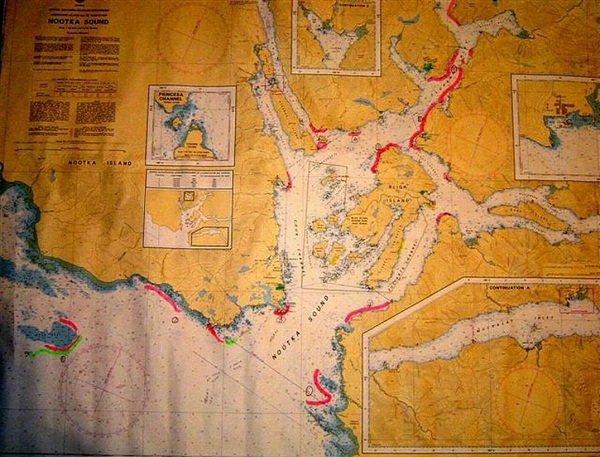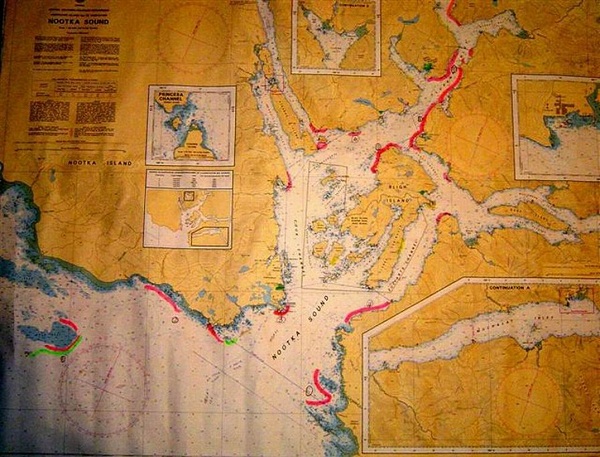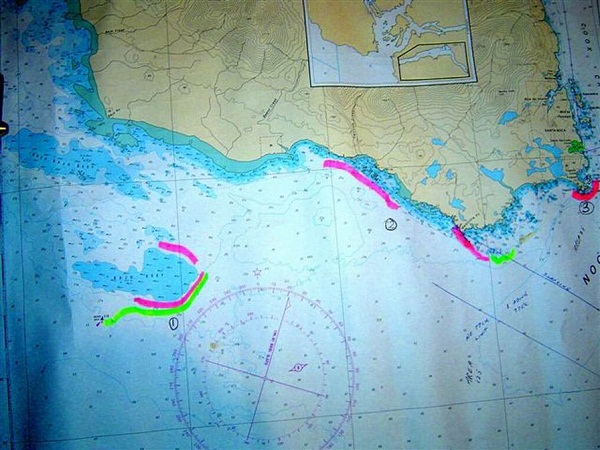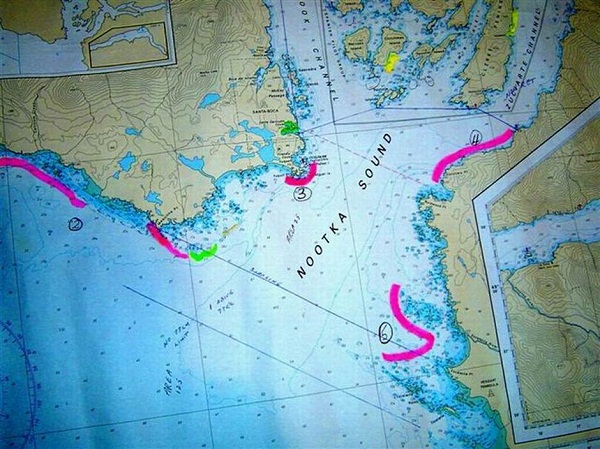Nootka Sound
contributed by Mike Cummings – Courtenay, B.C.
Nootka Sound is one of the largest and most protected of the 5 Sounds on the West Coast of Vancouver Island. It is accessed through and sometimes mistakenly called Gold River. Located mid-way up the West coast of Vancouver Island it is renowned for its large and abundant runs of Springs (King), Coho (Silvers), and Chum Salmon. Springs of 30 to 40 Lbs are quite common and there is always a fish or two over 50 pounds each season. Coho (Silvers) are present in large numbers and are often in the 18 to 20 lb range.
Off-shore there is good to excellent, Ling cod, Snapper and Black bass fishing plus the Salmon can be down-right spectacular. Halibut are available, and while not as numerous as Quatsino Sound they tend to average quite a bit larger in size.
Fishing at Nootka Sound intercepts most of the Salmon runs bound for mainland B.C., Vancouver Island, Washington and Oregon State Rivers. In addition, Nootka fish are also homeward bound to the Gold, Burman, and most importantly the Conuma River and it’s hatchery. It is the Conuma River Hatchery, which enables anglers in the Nootka Sound area to enjoy the most generous Coho limits of marked or unmarked fish on the West Coast.
Where and When to Fish
Area 1
Outer Bajo Reef- This is a vast area of kelp and shallow water, frequented by lots of bait and Grey whales. The big Springs will show up on the Reef sometime in the last weeks of June. These are not always Nootka Sound fish and are often very aggressive feeding Springs and Coho bound for other areas. The water around the Reef is from 35 to 90 feet deep and the best tactic is to contour the Reef at various depths. The Reef always holds fish no matter what tide, but try and put the reef between you and the tide flow thus aligning yourself and the bait in a back eddy. This area is great fun to fish; fish too close to the bottom and you will certainly get Ling Cod or Black Bass, as they are here in great abundance.
There is a large Red Navigation buoy, which marks the outside edge of Bajo reef. From this point fish directly seaward and incorporate some of the deep trolling techniques listed on this web site and found so effective at Winter Harbour. Big Springs, Coho and Halibut frequent the deeper water known to commercial fishermen as the 50 Fathom line (300 ft).
Tackle
Anchovy on a 60 to 72 inch tie behind your favorite flasher (hot spot, Ok’i etc); cut plug herring, Dymara Lazer skirt (new) 40 inch tie for silvers, 42 to 48 inches for Kings, various colored hootchies and of course spoons either Coyote or Dymara in green and chrome or cop car type colors.
The Reefs remain excellent places to fish throughout the summer and fall but make sure you have a chart #3675 and GPS as this area is prone to sudden fog.
Area 2 – North
This area, usually called Beano Creek, is extremely picturesque with features such as huge tidal caves and large bait holding kelp beds. In the late weeks of June and early July fish fairly tight to the kelp; follow the shoreline with 25 to 45 feet on down riggers. If the bait is in, there is often very good fishing for Springs and Coho and the occasional large ling. This area is often calmer than Area 1 and always more comfortable to fish than Area 2-South, however, if there is no bait showing, give it a short try and if unsuccessful, move.
Area 2 – South
Maquinna Pt. or Wash Rock. – One of the premier places to fish for the really big Springs. This is the first place that you can be sure you are into a “true Nootka Sound Spring”. The first big Spring or King will be taken here in the last days of June to the first days in July. It signals the start of a “river of fish” which will flow into the Sound on each successive flood tide. The water along this shore, close to the rocks and kelp, is about 70 ft deep and should be fished from 25 to 45 ft on your downrigger. Be careful!!! Watch the other boats and study your charts and sounder -there are a few spots that can be hard on tackle. Anchovy or cut plug herring is the first choice for bait, followed by Lazer skirts, hootchies and spoons. If you are not taking fish and other boats are and you are fishing anchovy, lengthen your leader to 8 to 10 feet from the flasher. Other options are anchovy or spoon only, no flasher; flasher on one side of the boat only or consider a flasher only on your weight and a lure or bait above it. The really big Springs will not be feeding at this point and it seems that they become “flasher shy” so inside the Sound keep this in mind if you seem to be the only boat not taking Springs. Coho or Silvers don’t seem to be so particular.
This area can be choppy due to large tide changes and the ever-present “afternoon” inflow winds. Fish very early morning, late evening and “the flood tide”. Jig around ” Wash Rock” for Lingcod and other bottom fish including the odd Halibut.
Area 3 -“The Monument”
Called ” The Monument” for the stone cairn erected on the lighthouse point to commemorate the meeting of Capt Cook with the local “First Nations.” This is where the early action takes place through most of July. This area can be crowded, especially in the early days of July when the fish aren’t into the Sound proper. Fish all around the point in 60 ft of water from 25 to 40 ft on the downriggers. Lures and leader lengths are the same as Area 2-South. Fish early morning, late evening and the tide changes. If the area becomes too crowded, fish outside the gaggle in deeper water and contour the bottom with your downriggers. Another option is to contour the several points heading west to Maquinna Pt; there are plenty of fish and it is often overlooked.
Area 4-Burdwood Bay
Great trolling water, fairly protected, and a real pleasure to fish. Start at the Navigation light on the South shore of Zuciarte Channel and troll along the shore to Burdwood Bay. Fish tight to the shore with 25 to 45 ft of wire on the downriggers. If you see bait out in the Channel, swing out and around. Try and get below it and you should pick up a Coho or a Feeder Spring. This shore yields some monster Springs!! Fish very early morning, evening and the Flood tide.
This Area, as well as Area 5, tends to be a later fishery than all the others mentioned. It does not usually come alive until the start of August. Some say that this is because these fish are bound for the Gold and not the Conuma River. Indeed, fish can be taken here well into October when there is little or no competition from other fishermen.
Area 5 – Escalante Pt.
More exposed than Area 4 and smaller. Contour the Kelp beds and the points-quite shallow; fish 25 to 45 ft as the bottom allows. Seems to produce on the Ebb tide. Try Area 4 first and if it is “slow ” try this area-quite often, as it seems to be a staging place before the fish move onto the Burdwood shore on the next Flood tide.
Area 6 – Hoiss Pt
This is what it’s all about!! Huge fish, great scenery and no fishermen!!! Two out of three ain’t bad! It can be crowded. Fish very early or very late to beat the crowd. Fortunately Nootka Sound is huge and boats tend to gather at known spots. Certainly there are fish there but these fish have one thought in mind and that is to get to the Conuma River. Fishing in the crowd doesn’t necessarily get you more fish, your presentation and shore contouring might not be ideal and in the end you will enjoy the experience much less. That said, there is no denying that from around July 10 and for 3 to 4 weeks after, Hoiss Point will host almost all of the huge Salmon run bound for the Conuma River. Contour the shore from the Fish boundary marker, northeast to in front of Hoiss Point Lodge using 25 to 45 ft on your downriggers. Anchovy, cut plug, (long leaders) are the baits that are most favored. Lazer skirts, hootchies, and spoons in cop car or army truck are the most prevalent colors for large Springs. Coho (Silvers) are a different subject at this point and I will address it separately at the end.
Area 7 – San Carlos Pt.
Fish from the Navigation light on the point, southward along the Bligh Island shore. Fish fairly tight to the shore using 25 to 70 ft on the downriggers. Directly across the Sound from Hoiss Point, it is fished much less intensely. In Aug 2003, at 4 in the afternoon, a friend of mine took a 50 1/2 lb fish on this shore. Our boats were the only ones fishing, while Hoiss point had a crowd. A great alternative to Hoiss Point. Fish early morning, evening and on the tide change.
Area 8 – Camel Rock and “The Wall”
Think of Nootka Sound as a large funnel, collecting Salmon from all over the coast. As time marches on, the salmon move further into this funnel whose tip happens to be the Conuma river. July gives way to August and the hot spots will move closer to the Conuma River. During August, start fishing from Camel Rock, contouring the shore northeastward past Galiano Bay; Cougar Creek and until directly across from Princess Royal Point. Fish the baits as previously discussed but if there are a lot of boats don’t be afraid to explore the 70 to 90 ft depths. Fish early mornings and evenings and all tide changes. If it becomes too crowded go to Area 9.
Area 9 – Hisnit to Princess Royal Point
One of the most overlooked areas in Nootka Sound. This area is protected, easy to troll; 25 to 70 ft and yet most people are drawn like magnets to the Camel Rock shore. Fish early morning, evening and tide changes. Usually good to excellent from the start of August into the first weeks of September. The end of the Spring fishing will depend on the start of the fall rains.
The Best Part
Nootka Sound is well known for its fabulous summer Chinook or King fishing. It attracts people from all over the world. Amazingly it becomes deserted in September, just when the huge Coho and Chum move in. There are so many Coho that the Dept. of Fisheries allows 4 Coho a day, marked (hatchery} or unmarked (wild). These Silvers can reach over 20 pounds and are incredible fighters. They will take a fly or a bucktail. You will still catch the odd Spring, particularly in Area 4, but Area 8 and Area 9 are the “hot spots”. That is, right in front of the nearly empty Cougar Creek campground and dock. Fish anchovy, (4 to 5 ft leader), pink /green green lazer skirt, pink / green hootchie, Dymara or Coyote spoons in pink or green.
Use downriggers to 30 feet and run a light rod with a pink/ green spoon, pink bucktail or anchovy in the prop wash. Fishing doesn’t get better than this but you may be lonely. Continues well into October.
How to get to Gold River and Nootka Sound:
Take the ferry from Tswassen to Duke Point. For a slight charge, you can make a reservation. You can either call BC Ferries from outside the province at 604-444-2890 or toll-free from anywhere in British Columbia at 888-724-5223. You can also make reservations on their website. ( www.bcferries.com). Driving time from Duke Point to Campbell River is 2 hours. At Campbell River, take Highway 28 to Gold River, an easy 1-hour drive. A good concrete boat launch is located 13 km (8 miles) southwest of Gold River on Muchalat Inlet. This ramp is usable for most boats down to a 2.5 ft low tide. It is run by the local “First Nations” and there is a charge for secure parking and launch. From the launch, it is an easy 30-minute run to Nootka Sound. You can get a multi day launch pass and it is feasible to either launch every day or tie up at the Government wharf and stay in a motel at Gold River. This will probably give you a total of 2 to 2 1/2 hours commute a day.
It is possible to drive right into Nootka Sound but it is over gravel logging roads and not recommended for large boats. At Gold River, follow the signs for Tahsis, cross the Gold River and continue on usually good gravel road for approx. 30 miles, turn left at the sign for Cougar Creek. It is approximately 10 to 12 miles on gravel logging roads into the Ministry of Forestry Campground at Cougar Creek. There are grades on this section of road to 15%. Drive carefully and watch for logging trucks. The boat launch is over the beach beside a large dock. I have launched a 21 ft glass boat there with little problem, but that is probably the maximum. Most people with large boats or a little less adventuresome prefer to launch at the ramp south of town. One other option exists and that is to travel the gravel road to Tahsis, drive past the Cougar creek turn-off and continue on to the Moutcha Bay turnoff. From that point it is only 3 miles to the Moutcha Bay Marina and RV Park. I do not know the condition of their ramp but they seem to have good accommodations at a reasonable price. www.moutchabay.com
Services available at Nootka Sound
There is no real town site other than the tourist stopover at Friendly Cove. Dock space, if required is limited and should be reserved in advance. Food, bait and tackle should be brought with you, as these supplies are limited. Critter Cove is the biggest Marina and does have good boat gas and quite a few dock spaces. They have accommodations, restaurant, showers, some tackle and boats for rent. www.crittercove.com.
Cougar Creek is a Forestry campground with approx. 50 sites, an over the beach launch and dock space for about 50 boats. Reservations cannot be made.
Tuta Marina is a rustic campground that is in the development stage. They have a fair number of tent sites, store and some wharfage, which fluctuates with the years. www.tutamarina.com. Phone 1-250-283-7550
Moutcha Bay Marina is well situated and seems to have good facilities. Check them out at www.moutchabay.com
Accommodation is available at many of the lodges around the Sound. Some offer self-guide packages with your own boat. They can be found on the “net” under Nootka Sound.”
Nootka Sound offers a number of secure anchorages if your boat is able to be self-contained. These are depicted on the Marine chart 3675.
Gold River has boat gas, accommodations, food and bait and tackle. Larger centers, such as Campbell River and Courtenay might be better choices to stock up on all supplies, especially fishing tackle and bait.
How to Fish for Salmon | How to Catch Salmon | How to Fish for Tuna | How to Catch Tuna | How to Fish for Halibut | How to Catch Halibut









